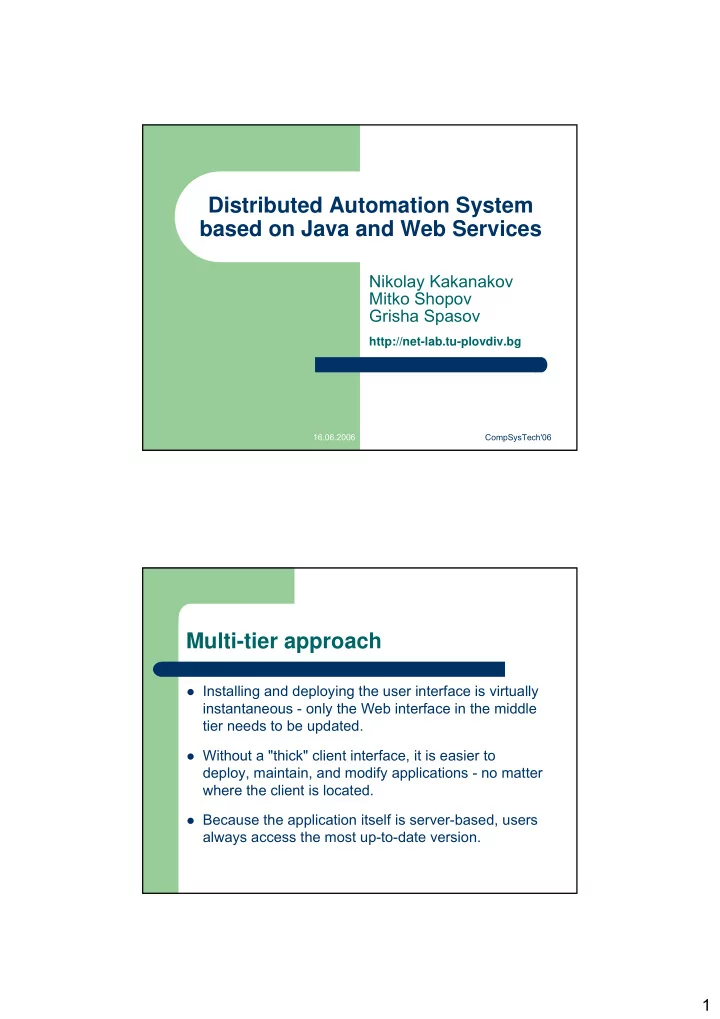

Distributed Automation System based on Java and Web Services Nikolay Kakanakov Mitko Shopov Grisha Spasov http://net-lab.tu-plovdiv.bg 16.06.2006 CompSysTech'06 Multi-tier approach � Installing and deploying the user interface is virtually instantaneous - only the Web interface in the middle tier needs to be updated. � Without a "thick" client interface, it is easier to deploy, maintain, and modify applications - no matter where the client is located. � Because the application itself is server-based, users always access the most up-to-date version. 1
Web Service Architecture � Ubiquitous infrastructure – they operate over standard TCP/IP networks and use ubiquitous HTTP/SMTP for transport. � Proven approaches – they use both message-oriented and RPC-based interaction which makes them flexible. � XML – they do not need specific IDL for describing the interfaces and the data entities are self-describing. � Business standards – Business-to-Business interaction is by means of standard documents and processes. Enterprise portal technology Motivation � Spreading of enterprise resources over large distances; � Complexity and expensiveness of modern software; Benefits � Provide a single point of entry for different type of clients; � Can access Web services transparently from any device in virtually any location; � Provide the ability to integrate disparate systems and leverage the functionality provided by those systems. 2
N-tier Model for Distributed Automation Sample Implementation 3
Localization of Services � Peer-to-Peer and Central Directory approaches � Universal Description, Discovery and Implementation (UDDI) – part of the WSA specification � Public and Private UDDI registries � Dynamic binding is used simply to determine the location of well defined services Portal – access Web Services <JSP: useBean id=“ wsc " class=“webServices.clients" /> Average Temperature: <JSP: getProperty name=“wsc“ property=“ avgTemperature " /> Average Humidity: <JSP: getProperty name=“wsc" property=“ avgHumidity " /> 4
SOAP request message POST /axis/services/ProcessTemperatureSOAP HTTP/1.0 Content-Type: text/xml; charset=utf-8 Accept: application/soap+xml, application/dime, multipart/related, text/* User-Agent: Axis/1.3 Host: 192.168.2.98 Cache-Control: no-cache Content-Length: 506 <?xml version="1.0" encoding="UTF-8"?> <soapenv:Envelope xmlns:soapenv="http://schemas.xmlsoap.org/soap/envelope/" xmlns:xsd="http://www.w3.org/2001/XMLSchema" xmlns:xsi="http://www.w3.org/2001/XMLSchema-instance"> <soapenv:Body> <ns1: request soapenv:encodingStyle="http://schemas.xmlsoap.org/soap/encoding/"> <in0 xsi:type="soapenc: string "> Average </in0> </ns1: request > </soapenv:Body> </soapenv:Envelope> SOAP reply message HTTP/1.1 200 OK Server: Apache-Coyote/1.1 Content-Type: text/xml;charset=utf-8 Date: Mon, 10 Apr 2006 09:16:54 GMT Connection: close <?xml version="1.0" encoding="utf-8"?> <soapenv:Envelope xmlns:soapenv="http://schemas.xmlsoap.org/soap/envelope/" xmlns:xsd="http://www.w3.org/2001/XMLSchema" xmlns:xsi="http://www.w3.org/2001/XMLSchema-instance"> <soapenv:Body> <ns1:response soapenv:encodingStyle="http://schemas.xmlsoap.org/soap/encoding/"> < temperature xmlns="http://net-lab.tu-plovdiv.bg/ProcessTemperature/" ID="Data" > <context-type> application/temperature </context-type> <data> 24.82 </data> </ temperature > </ns1:response> </soapenv:Body> </soapenv:Envelope> 5
Conclusions and Future Work Conclusions � Multi-tiered, well-proven architecture models, popular and standard technologies brings various advantages, added flexibility, scalability and increase its security and reliability � The Service-oriented middleware used allows spreading the system over large distances (WAN) Future Work � Evaluation of request/response times � Estimation of the effectiveness in a function of the server and network load � Applying web services architecture to the Data tier – directly to the embedded devices Acknowledgments The presented work is supported by National Science Fund of Bulgaria project – “ ВУ -966/2005”, entitled “Web Services and Data Integration in Distributed Automation and Information Systems in Internet Environment”, under the contract “ ВУ - МИ -108/2005”. 6
Q & A 7
Recommend
More recommend